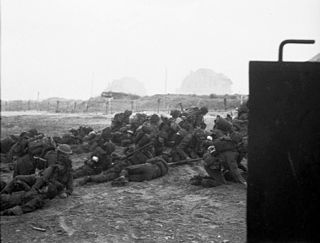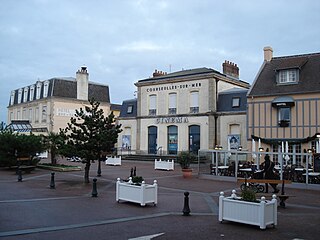Related Research Articles

Juno and or Juno Beach was one of five beaches of the Allied invasion of German-occupied France in the Normandy landings on 6 June 1944 during the Second World War. The beach spanned from Courseulles, a village just east of the British beach Gold, to Saint-Aubin-sur-Mer, and just west of the British beach Sword. Taking Juno was the responsibility of the First Canadian Army, with sea transport, mine sweeping, and a naval bombardment force provided by the Royal Canadian Navy and the British Royal Navy as well as elements from the Free French, Norwegian, and other Allied navies. The objectives of the 3rd Canadian Infantry Division on D-Day were to cut the Caen-Bayeux road, seize the Carpiquet airport west of Caen, and form a link between the two British beaches on either flank.

Sword, commonly known as Sword Beach, was the code name given to one of the five main landing areas along the Normandy coast during the initial assault phase, Operation Neptune, of Operation Overlord. The Allied invasion of German-occupied France commenced on 6 June 1944. Stretching 8 kilometres (5.0 mi) from Ouistreham to Saint-Aubin-sur-Mer, the beach proved to be the easternmost landing site of the invasion after the abortion of an attack on a sixth beach, code-named Band. Taking Sword was to be the responsibility of the British Army with sea transport, mine sweeping and a naval bombardment force provided by the British Royal Navy as well as elements from the Polish, Norwegian and other Allied navies.

The Commandos, also known as the British Commandos, were formed during the Second World War in June 1940, following a request from Winston Churchill, for special forces that could carry out raids against German-occupied Europe. Initially drawn from within the British Army from soldiers who volunteered for the Special Service Brigade, the Commandos' ranks would eventually be filled by members of all branches of the British Armed Forces and a number of foreign volunteers from German-occupied countries. By the end of the war 25,000 men had passed through the Commando course at Achnacarry. This total includes not only the British volunteers, but volunteers from Greece, France, Belgium, Netherlands, Canada, Norway and Poland. The United States Army Rangers and US Marine Corps Raiders, Portuguese Fuzileiros Portuguese Marine Corps were modelled on the Commandos.

No. 3 Commando was a battalion-sized Commando unit raised by the British Army during the Second World War. Formed in July 1940 from volunteers for special service, it was the first such unit to carry the title of "Commando". Shortly afterwards the unit was involved in a largely unsuccessful raid upon the German-occupied Channel Island of Guernsey.

No. 4 Commando was a battalion-sized British Army commando unit, formed in 1940 early in the Second World War. Although it was raised to conduct small-scale raids and harass garrisons along the coast of German occupied France, it was mainly employed as a highly trained infantry assault unit.
During World War II, Operation Abercrombie was an Anglo-Canadian reconnaissance raid on the area around the French coastal village of Hardelot, located south of Boulogne-sur-Mer, in the Pas-de-Calais. It had been scheduled for the night of 19/20 April 1942, but delayed until 21/22 April. The raid was largely unopposed but, on review, the benefits were thought not to have been worth the effort. Due to a navigation error the Canadian detachment lost their way and had to abort.

Bény-sur-Mer is a commune in the Calvados department in the Normandy region, in northwestern France. It lies 5 km south of Bernières-sur-Mer and 13 km north of Caen.

Courseulles-sur-Mer, commonly known as Courseulles, is a commune in the Calvados department, Normandy, northwestern France. Until 1957, the town's name was simply Courseulles. It lies 3 km west of Bernières-sur-Mer and 18 km north of Caen.

The 716th Static Infantry Division was a World War II, German Army infantry division. It was raised on May 2, 1941, and sent to German-occupied France in June 1941. Many of the division's troops were elderly Germans and conscripts from other German-occupied countries. The division also had some young German conscripts as well. As a bodenständig it was not equipped with the standard configuration of vehicles and heavy weapons. Much of the division's artillery and anti-tank guns were from captured armaments.

La Combattante was a destroyer of the Free French Naval Forces (FNFL). A British-built Hunt-class destroyer, she was offered to the Free French in 1942.

The Canadian Army Film and Photo Unit (CFPU) was a Canadian Army unit founded in 1941 in order to document military operations during World War II. It was the last unit of its kind to be founded by the Allied armies. Among the campaigns which it recorded were the invasion of Sicily, the D-Day landings, the liberation of Paris and the Elbe River link-up of the Allied armies, known as 'Elbe Day'.

The 1st Special Service Brigade was a commando brigade of the British Army. Formed during the Second World War, it consisted of elements of the British Army and the Royal Marines. The brigade's component units saw action individually in Norway and the Dieppe Raid, before being combined under one commander for service in Normandy during Operation Overlord. On 6 December 1944, the Brigade was redesignated 1st Commando Brigade, removing the title Special Service and its association with the German SS.
The 4th Special Service Brigade was a brigade-sized formation of the British Commandos formed during the Second World War in March 1944 from battalion-sized units of the Royal Marines. Due to the success of the British Army Commandos' operations in Norway, the Channel Islands, St. Nazaire, and the Middle East, the Admiralty dissolved the Royal Marines Division in late 1942 and reorganized its amphibious assault infantry into eight additional Commando units.
1er Bataillon de Fusiliers Marins Commandos was a Fusiliers Marins commando unit of the Free French Navy, raised in 1942, which served during the Second World War. Its initial Commandant was then-Lieutenant de Vaisseau (Captain) Philippe Kieffer of the Free French Navy, under whose command they participated in the Normandy landings in 1944.

No. 10 (Inter-Allied) Commando was a commando unit of the British Army during the Second World War, recruited largely from non-British personnel from German-occupied Europe. This unit was used to help co-ordinate attacks with other Allied forces.
No. 2 Commando was a battalion-sized British Commando unit of the British Army during the Second World War. The first No.2 Commando was formed on 22 June 1940 for a parachuting role at Cambrai Barracks, Perham Down, near Tidworth, Hants. The unit at the time consisted of four troops: 'A', 'B', 'C' and 'D'. Eventually 11 troops were raised. On 21 November, it was re-designated as the 11th Special Air Service (SAS) Battalion and eventually re-designated 1st Parachute Battalion. After their re-designation as the 11th SAS Battalion, a second No. 2 Commando was formed. This No. 2 Commando was the leading commando unit in the St Nazaire Raid and suffered heavy casualties. Those who made it back from St Nazaire rejoined the few who had not gone on the raid, and the commando was reinforced by the first intake of volunteers from the new Commando Basic Training Centre at Achnacarry. No. 2 Commando then went on to serve in the Mediterranean, Sicily, Yugoslavia, and Albania, before being disbanded in 1946.
No. 48 Commando was a battalion-sized formation of the British Commandos, formed in 1944 during the Second World War. No. 48 Commando was assigned to the 4th Special Service Brigade and served in North West Europe, taking part in the Normandy landings and operations around Ostend and Antwerp before being disbanded after the war in January 1946.

The Commandos formed during the Second World War, following an order from the British Prime Minister Winston Churchill in June 1940 for a force that could carry out raids against German-occupied Europe. Churchill stated in a minute to General Ismay on 6 June 1940: "Enterprises must be prepared, with specially-trained troops of the hunter class, who can develop a reign of terror down these coasts, first of all on the "butcher and bolt" policy..." Commandos were all volunteers for special service and originally came from the British Army but volunteers would eventually come from all branches of the United Kingdom's armed forces and foreign volunteers from countries occupied by the Germans. These volunteers formed over 30 individual units and four assault brigades.

Operation Aquatint was the codename for a failed raid by British Commandos on the coast of occupied France during the Second World War. The raid was undertaken in September 1942 on part of what later became Omaha Beach by No. 62 Commando, also known as the Small Scale Raiding Force.

This is the Juno Beach order of battle on D-Day.
References
- ↑ "Naval Codewords". Naval History. Retrieved 11 June 2010.